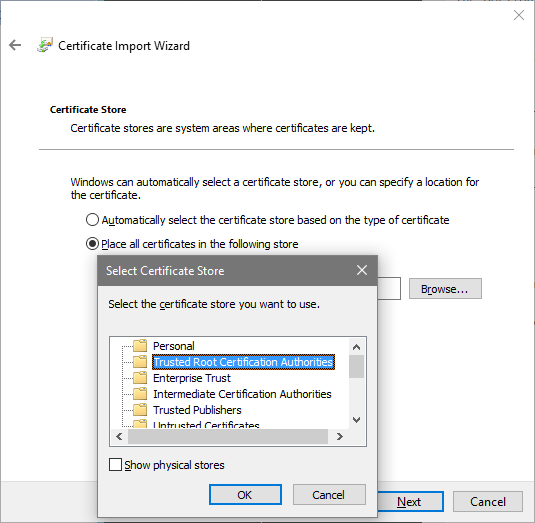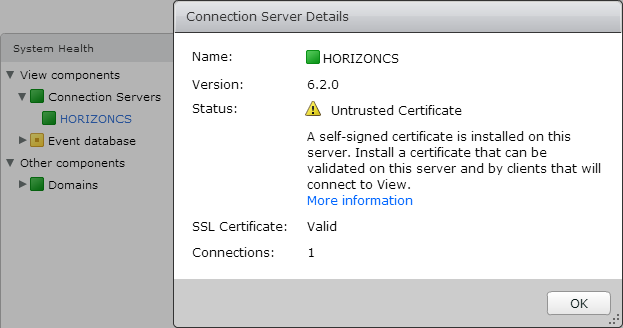Hi Amin,
I did some work recently:
1. I followed this post’s instructions, and a self-signed certificate is installed on horizon connection server and the details of it in the connection server console is shown in figure below.
however, my VDI session tests’ results were not perfect and some client windows VMs still have the SSL error.
note that my client windows VMs are provisioned by the Horizon too.
so is it possible that the SSL error problem persist due to the «untrusted certificate»??
2. do I need to import the connection server’s certificate into all the client VMs’ MMC?
3. I checked the Horizon Client’s logs on different windows desktops that had this «SSL error» and they all showed similar errors, as listed below:
ERROR (0750) [WinCDK] utils::ParseServerUrl : Unexpectedly unable to parse URL ».
ERROR (077C) [WinCDK] UpdateMgrCDS::CdsLogCallback : CdsUtil_RemoveFile: Unable to remove file C:UsersuserAppDataLocalTempcdstmp_1692_0
ERROR (077C) [WinCDK] UpdateMgrCDS::CdsLogCallback : Failed to finish active transfer for https://softwareupdate.vmware.com/horizon-clients/index.xml: CDS_HTTP_HOST_RESOLVE_ERROR
INFO (0750) [WinCDK] BaseServices::ErrorCallback : Error(Taskname:CdkSetLocaleTask, domain:54, code:35) Callback: Entry.
ERROR (0750) [WinCDK] DefaultErrorHandler::ProcessError : DefaultErrorHandler process error ‘Error: An SSL error occurred’ (code=35).
ERROR (0468) [WinCDK] UpdateMgrCDS::CdsLogCallback : CdsUtil_RemoveFile: Unable to remove file C:UsersuserAppDataLocalTempcdstmp_7824_0
2019-10-28T20:26:35.526-07:00| host-1128| I125: DictionaryLoad: Cannot open file «C:ProgramDataVMwareVMware Horizon Viewconfig.ini»: The system cannot find the file specified.
2019-10-28T20:26:35.526-07:00| host-1128| I125: [msg.dictionary.load.openFailed] Cannot open file «C:ProgramDataVMwareVMware Horizon Viewconfig.ini»: The system cannot find the file specified.
2019-10-28T20:26:35.526-07:00| host-1128| I125: PREF Optional preferences file not found at C:ProgramDataVMwareVMware Horizon Viewconfig.ini. Using default values.
2019-10-28T20:26:35.541-07:00| host-1128| I125: DictionaryLoad: Cannot open file «C:ProgramDataVMwareVMware Horizon Viewsettings.ini»: The system cannot find the file specified.
2019-10-28T20:26:35.541-07:00| host-1128| I125: [msg.dictionary.load.openFailed] Cannot open file «C:ProgramDataVMwareVMware Horizon Viewsettings.ini»: The system cannot find the file specified.
2019-10-28T20:26:35.541-07:00| host-1128| I125: PREF Optional preferences file not found at C:ProgramDataVMwareVMware Horizon Viewsettings.ini. Using default values.
2019-10-28T20:26:35.541-07:00| host-1128| I125: DictionaryLoad: Cannot open file «C:ProgramDataVMwareVMware Horizon Viewconfig.ini»: The system cannot find the file specified.
2019-10-28T20:26:35.541-07:00| host-1128| I125: [msg.dictionary.load.openFailed] Cannot open file «C:ProgramDataVMwareVMware Horizon Viewconfig.ini»: The system cannot find the file specified.
2019-10-28T20:26:35.541-07:00| host-1128| I125: PREF Optional preferences file not found at C:ProgramDataVMwareVMware Horizon Viewconfig.ini. Using default values.
2019-10-28T20:26:35.541-07:00| host-1128| I125: DictionaryLoad: Cannot open file «C:UsersuserAppDataRoamingVMwareconfig.ini»: The system cannot find the file specified.
2019-10-28T20:26:35.541-07:00| host-1128| I125: [msg.dictionary.load.openFailed] Cannot open file «C:UsersuserAppDataRoamingVMwareconfig.ini»: The system cannot find the file specified.
2019-10-28T20:26:35.541-07:00| host-1128| I125: PREF Optional preferences file not found at C:UsersuserAppDataRoamingVMwareconfig.ini. Using default values.
I attached the logs but I don’t think these error messages truly help.
can anyone provide some clues?
,
last updated February 17, 2016, in
This is a description of a quick and dirty way to get SSL to work correctly in a VMware Horizon View installation in a lab environment. Do not do this in production!
The Situation
The Horizon View Connection Server installer creates a self-signed certificate which it places in the computer’s personal certificate store. This certificate’s root is not trusted by anyone, least of all by the clients trying to connect to your apps and desktops.
Establishing Trust
To make the default self-signed certificate work correctly you need to export it from the computer’s personal certificate store and then re-import it in the trusted root certificate store.
Exporting
It is OK to export without a private key; leave the file format at the default.
Importing – Connection Server
When re-importing the key on the Horizon View Connection Server manually select the computer’s Trusted Root Certification Authorities store:
After the import restart the Connection Server machine. View Administrator should now display the Connection Server status in green (certificate valid):
Importing – Clients
Clients that connect to Horizon need the certificate imported as trusted root certificate in the same way as described for the Connection Server above.
Name Resolution
Clients connecting to Horizon View need to be able to resolve the name as it is stored in the certificate, in all likelihood fully qualified. If your (lab) clients use a different DNS server than the Horizon installation the simplest solution is to add the Connection Server’s name and IP address to each client’s hosts file.
About the Author
Helge Klein (ex CTP, MVP and vExpert) worked as a consultant and developer before founding vast limits, the uberAgent company. Helge applied his extensive knowledge in IT infrastructure projects and architected the user profile management product whose successor is now available as Citrix Profile Management. Helge is the author of the popular tools Delprof2 and SetACL. He has presented at Citrix Synergy, BriForum, E2EVC, Splunk .conf and many other events. Helge is very active in the IT community and has co-founded Virtualization Community NRW (VCNRW).
Read more
I just did a Horizon View Upgrade from 5.2 to Horizon 7 for a large customer who uses Zero Clients for every employee. The customer is using Dell Wise P25 Zero Clients for most employees, but still have the older P20 for a select few. Both the P20 and P25 uses chipsets from Teradici, but the firmware on each is slightly different.
After the upgrade, employees using the older P20 Zero Clients would get the following error when trying to connect to their View session:
SSL Session Negotiation Failed or The Zero Client may not be compatible with the host session negotiation cipher settings.
After much research, I found a few KBs and Posts with the apparent “fix”, but none of them worked as they claimed – at least not in this environment. After spending many hours trying to resolve this, I found a solution that worked for this client. I hope this helps someone else.
This issue affects Horizon View 6.2 and 7.0. The root cause of this is due to VMware disabling support for the less secure TLS 1.0 protocol. The P25 Zero Clients need the latest 4.8 Firmware, which addresses the problem, but the P20 Zero Client’s only support firmware up to 4.5, which does not address this issue, so a workaround is needed. After following some blogs about importing a Group Policy, I found it to be a waste of time. So here is what actually works.
On each virtual desktop (or gold image), you’ll need to add the following Registry Key:
HKLMSoftwareTeradiciPCoIPpcoip_admin
Name: pcoip.ssl_protocol
Type: REG_SZ
Value: TLS1.0:TLS1.1:TLS1.2
Or download and import this .reg file I created with these settings: Regedit File Download
This allows TLS 1.0 connections via the installed agent.
On the Connection Server, edit the Connection Server Settings and uncheck Secure Tunnel
View Configuration – Servers – Connection Servers – Edit
This will allow connections to Authenticate through the Connection Server and then connect directly to the Virtual Desktop.
This fixed the issue for the customer until they can replace their older Zero Clients.
*Posts on this site may contain affiliated links*





